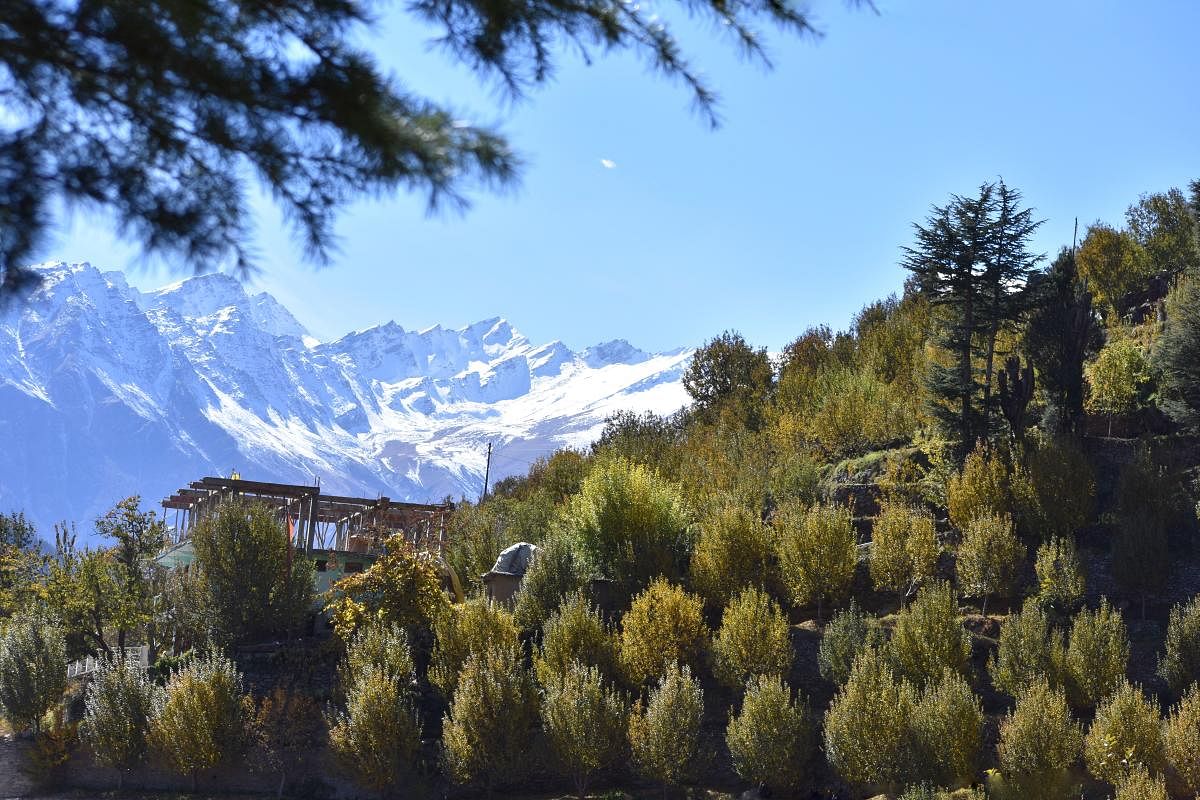
Although not so keen on solo travelling, that’s how life threw itself upon me when my itchy feet rared to travel. The mountains beckoned and I had decided to visit the Kinnaur valley in Himachal Pradesh.
The journey in the UNESCO World Heritage Mountain Railways to Shimla through the verdant hills set a good preamble for my trip. The actual trip started from Shimla on a cold morning when I boarded a bus for the journey ahead. The sparkling dew formed a vibrant spectrum with the early morning’s rays before an endless line of snow-capped mountains appeared on the horizon. With quick stopovers at the erstwhile palace of Rampur Bushehr and at Sarahan, one of the shakthi peethas, the journey thereafter can be broadly classified into two. First being the Sangla Valley, and the second, Spiti Valley, each characterised by typical landscape and cultural influence on the Kinnauri people living there.
Busy hub
The entire Sangla Valley is overlooked by the Kinnaur Kailash mountains where pilgrims flock every year. The manifestations of Shiva and Parvathi is believed to be seated there. The sunsets over these mountains have a magical spell with the crimson sun casting a golden glow on the entire range that can be watched from just about anywhere. The journey on this part of the valley took a longer time, which is characterised by steep, blind corners, breathtakingly scary heights of the snaking roads, roadside waterfalls, river crossings, cliff-hangers and landslides. The buckwheat farms and orchards of apples, apricots and walnut had painted the villages in shades of crimson, chrome and ochre, making the entire valley look splendid. A hike up the Kamru Fort at Sangla, a drive to Chitkul (the last Indian village bordering China and Tibet), a stay in traditional stone houses at Kalpa, a walk through the famous Kinnaur apple orchards, the suicidal roads of Roughi are some of the highlights of this region. Reckong Peo is the district headquarters and is called the ‘Gateway to Kinnaur Valley’ as it connects all other areas. Pine-nuts, dried apples, apricots and the Kinnauri hats are some of the souvenirs I brought with me from Sangla. After sipping some local apple brew, I was ready to head to my next destination. The road ahead slowly begins to surprise you. The transition from Sangla to Spiti is evident in both the landscape and its people. The green canopies make way to rocky cliff-hangers eventually opening to barren landscapes with sand and loose rocks. The blue Sutlej snaking along the treacherously winding roads between the valley is a feast to the eyes. The snow-capped mountains appeared farther, the nights got colder and the glitzy sky seemed more surreal. The stay at one of the traditional houses at Nako village for the night was nothing short of a fairy tale. My morning walk through the narrow walkways felt as if I was exploring a maze. Those winding lanes of Nako are compactly filled with houses built of wood and clay. From there, I hitched a ride to my next destination, Geu.
A town of mummies
I hiked up the hill at Geu to see the mummy of a Buddhist monk, one among the few mummies available in India. Strangely, it has been there in the open for over 500 years without any chemicals. The family that offered a ride to this village also invited me to attend a wedding that was taking place in this tiny hamlet. From being treated to the finest Kinnauri delicacies to dancing with the baraathis in a traditional mountain wedding, I could not have asked for more.
The weather got worse the next morning with a forecast of precipitation by the end of the day. A family in a loaded car offered to drop me to Tabo, the destination I had been looking forward to all the way. It is considered as one of the holiest places for Tibetan Buddhists. The Dalai Lama himself had once expressed his desire to retire here. The millennium-old monastery sets out a different vibe with its clay walls and fragrant Juniper interiors and old paintings that adorn all its inner walls and roofs. It is called the ‘Ajanta of the Himalayas’. I stayed at the monastery for the night and when I woke up in the morning, it felt as if the mountains had moved closer to me. It had snowed heavily overnight and it was a sight to which the heart of a snow-deprived south Indian city girl in me had skipped a beat. The only bus that connects the valley did not turn up for the next two days and hence, I had to extend my stay at the monastery. With no electricity, no phone connectivity, no plumbing and a diet comprising of the juiciest Tabo apples, I was living a dream! My return to Shimla was equally spellbinding with the same valley which had now been painted white in snow. With the changing landscape throwing surprises at the wink of an eye, each mile was magic. When the mountains beckon, just pack your bag and head out!